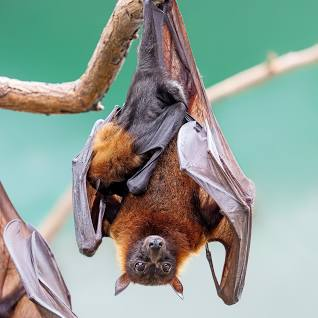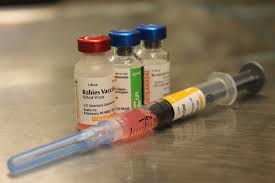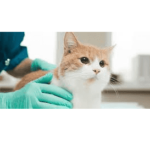Rabies has existed for a long time and is one of the most serious viral infections for people and mammals alike, as there are no second-chances. It is always fatal (with the exception of a case where a female was placed into a coma while her body had time to mount an immune response).
The good news, is: The virus does not survive outside of the infected host very long. Direct contact from infected salvia or a bite is required for transmission.

Most individuals get infected from an animal bite from wildlife harboring the infection such as a racoon, bat, or fox. However, in some cases, cats and dogs that become infected may spread it to their human companions.
When wildlife starts coming into contact with the pet population, pets may become infected and then, human infection follows.
Because Rabies infection has a 100% mortality rate, it is essential to prevent this in your cats, dogs and other mammalian household animals including ferrets.
Common wildlife species that have the virus in North America are skunks, bats, raccoons, foxes, and coyotes.

It can take many months for the virus to incubate and an individual to become symptomatic, but once even mild symptoms begin, death occurs within 10 days.
The injection treatment most people have heard of only works during the incubation period; once symptoms have started, survival chances are unlikely.
How The Disease Moves in the Body
Virus enters an individual through broken skin and is transmitted via infected saliva. The virus invades the muscle for a few days before moving into the nearby nerves and slowly travelling to the brain.
Inside the nervous system, the virus evades the immune system. The journey from nerve tissue to the brain can be slow – it is based on where the virus first enters the body.
The closer the wound to the brain, the faster symptoms are seen. Once the virus moves to the brain, only days are needed before it enters salivary secretions and can be spread through bites.
At this time, the infection is transmissible and symptoms begin.
Stages of Noted Infection: Prodromal Stage (Days 2-3 After Symptoms Start)
Personality change is evident. Friendly animals become shy, etc. The larynx begins to spasm and a voice change may be noted (especially true in rabid cattle).
Most infected animals will actively lick or scratch the site of the original bite. Because of laryngeal spasms and trouble with nerves in this area, swallowing becomes difficult which is why we think of a drooling dog when we picture a visual of rabies.
Excitative Stage (Day 1-7)
This would be the “mad dog” stage, though, in reality, most animals skip this phase altogether. The animal has no fear and suffers from hallucinations. If confined, the animal often attacks the bars of the cage. In the prey species such as cattle, instead of aggression, a “dumbness” or stupor is noted.
Paralytic Stage (Days 2-4)
Weakness/paralysis sets in. The larynx is paralyzed, resulting in an inability to swallow, thus drooling and “foaming at the mouth” result. There is no treatment for animals or humans once clinical signs appear.
When human exposure to the animal in question is involved, what happens depends on an assortment of criteria. If the animal in question is dead, its brain can be tested for rabies.
There is no test for rabies in a living animal but since we know that death follows quickly after the virus becomes contagious, a living animal that is suspected of being rabid can be quarantined for 10 days.
If the animal is still alive 10 days after biting a person and shows no neurologic changes, then the bite could not have transmitted rabies.
Prevention in our pets

Thankfully, rabies prevention via vaccination is readily available and very effective. There are vaccinations available for dogs, cats, ferrets and even people that work in high-risk fields (including veterinary medicine).
Rabies vaccination protocols are typically controlled by local municipalities. Most communities legally require the vaccination of all dogs. The American Association of Feline Practitioners recommends rabies vaccination as a core vaccine pet cats.
For pets not current on rabies vaccination that have been exposed to biting wildlife, the Texas Post-Exposure Rabies Prophylaxis Protocol has been particularly helpful.
Here, the pet should be vaccinated for rabies as soon as possible after the wildlife bite with booster vaccines given three weeks post-bite and eight weeks post-bite.
The pet should be strictly isolated for 90 days. This protocol has been extremely successful in preventing rabies symptoms and contagion when normal rabies vaccination had lapsed.
For people – if you are bitten by an animal (even a domestic dog or cat) and its rabies vaccination history is unknown, there are steps to take. A fresh bite wound should be washed out with water quickly as this may wash out viral particles.
The time it takes for the virus to reach the brain depends on how close the wound is to the brain. This simple step can be life-saving.
If the biting animal is alive, its vaccination status should be confirmed as soon as possible and it will need to be confined according to local law.
The bite wound should be reported to the health department as soon as possible. Please note, rodent and rabbit bites are not reportable.
If the animal is dead then its brain can be tested for rabies. The head of the biting animal is submitted to the health department for special testing.
This process takes a matter of hours so that any bite victims can know right away if they will require rabies treatment.
If the animal is not available or its vaccination status is in question, further treatment may be needed. humans should consult their human medical doctor immediately for protocols and possible preventative treatment.


